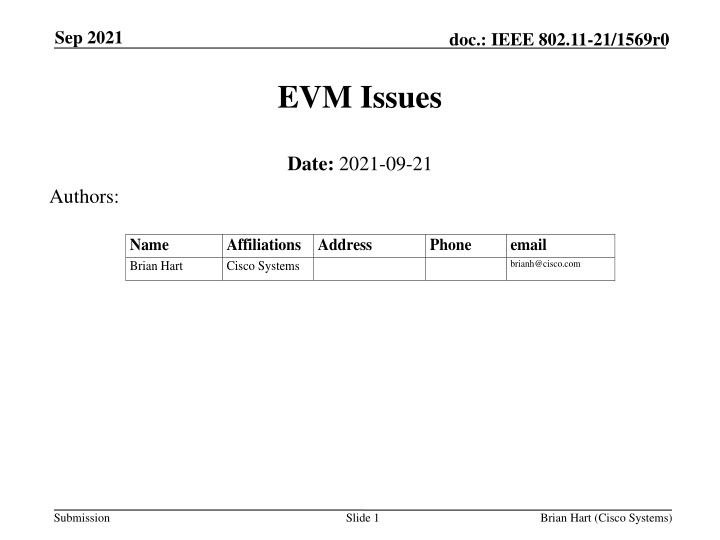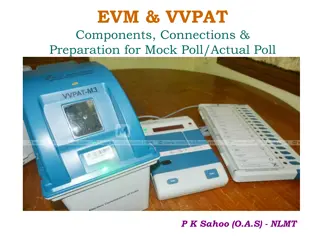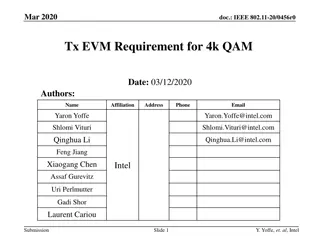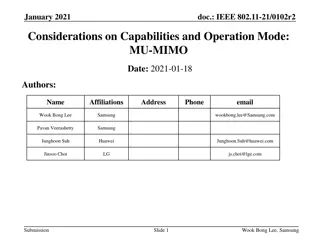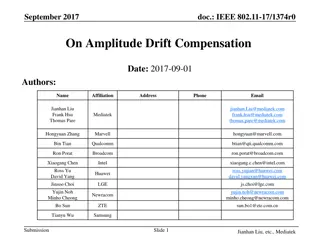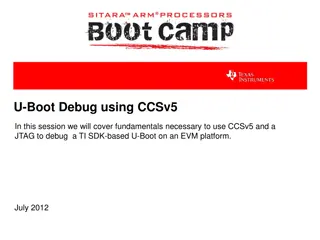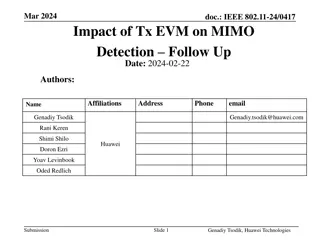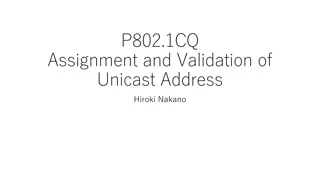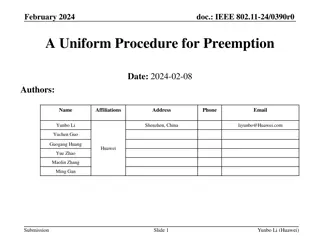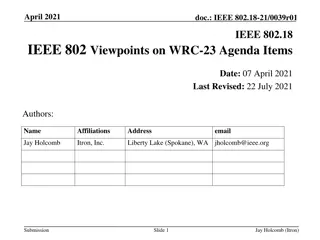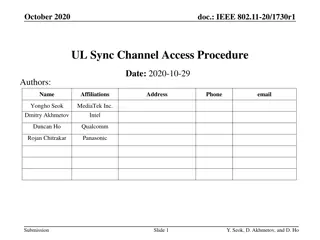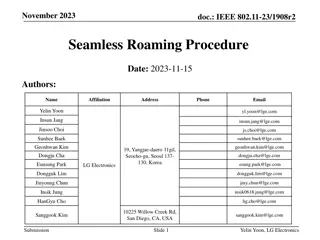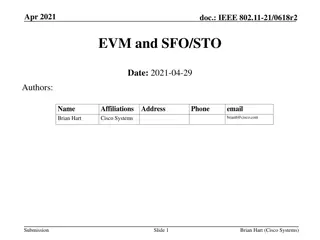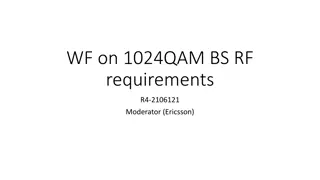IEEE 802.11-21 EVM Test Procedure Analysis
This document discusses issues with the EVM test procedure in IEEE 802.11-21 standards, focusing on calculations, agreement discrepancies, ambiguity, and lack of interoperability documentation. It also explores the impact of oscillator offsets on STAUTs and the inadequacy of SFO/STO handling in EVM testing.
Download Presentation

Please find below an Image/Link to download the presentation.
The content on the website is provided AS IS for your information and personal use only. It may not be sold, licensed, or shared on other websites without obtaining consent from the author.If you encounter any issues during the download, it is possible that the publisher has removed the file from their server.
You are allowed to download the files provided on this website for personal or commercial use, subject to the condition that they are used lawfully. All files are the property of their respective owners.
The content on the website is provided AS IS for your information and personal use only. It may not be sold, licensed, or shared on other websites without obtaining consent from the author.
E N D
Presentation Transcript
Sep 2021 doc.: IEEE 802.11-21/1569r0 EVM Issues Date: 2021-09-21 Authors: Name Brian Hart Affiliations Address Cisco Systems Phone email brianh@cisco.com Submission Slide 1 Brian Hart (Cisco Systems)
Sep 2021 doc.: IEEE 802.11-21/1569r0 EVM Issues Issue A: Incorrect calculations by the receiving test equipment should not contribute to the numerator (error) quantity in the EVM calculation and thereby penalize the transmitter Issue B: If two entities (e.g., vendor and customer) independently follow the 802.11 EVM test procedures to test a STAUT, they should both agree if the STAUT passed or failed Issue C: One portion of the EVM test is ambiguous and different people interpret it differently: i.e., estimate the phase from the pilot subcarriers, derotate the subcarrier values according to {if (11a/HT) elseif VHT/HE the } estimated phase Issue D: The or equivalent procedure language, coupled with opaque and potentially variegated test equipment algorithms, provides no documented way to achieve interoperability. // Defer this topic until progress on Issues A-C, but see backup for more details Submission Slide 2 Brian Hart (Cisco Systems)
Sep 2021 doc.: IEEE 802.11-21/1569r0 Impact of Oscillator Offsets (1/2) In 5/6 GHz, STAUTs are allowed to have +-20ppm offset in their reference oscillator (+-25ppm at 2.4 GHz) This manifests itself as Carrier Frequency Offset (CFO; aka frequency offset ) within the mixer and Sampling Frequency Offset (SFO; aka sampling offset drift ) within the ADCs The EVM test procedures deal with CFO thoroughly and explicitly: Frequency offset is estimated and corrected during the preamble Because of various impairments, the test equipment can never estimate CFO perfectly, but the majority of the CFO is removed here The effect of any residual CFO (i.e., actual CFO minus estimated CFO) appears as Common Phase Error (CPE) that increases every OFDM symbol. The EVM procedure allows this CFO residue (and other impairments such as carrier phase noise) to be estimated and corrected using the pilot tones during the EHT-LTF and Data fields Submission Slide 3 Brian Hart (Cisco Systems)
Sep 2021 doc.: IEEE 802.11-21/1569r0 Impact of Oscillator Offsets (2/2) The EVM test procedures do not deal adequately/clearly with SFO/STO: The effect of any SFO (aka timing offset drift) appears as Symbol Timing Offset (STO) that increases every OFDM symbol. In longer PPDUs, uncorrected SFO dominates the EVM In 11a/HT/VHT, many members believe that there is no text that permits the correction of SFO (but STO might or might not be allowed: see Issue C) In HE/EHT, a one-time correction of SFO is permitted, but maybe more (see Issue C) The EVM test might use 16 or over 1500 OFDM symbols The PPDUs under test shall be at least 16 (or 32) data OFDM symbols long The EVM calculation uses all transmitted OFDM symbols: Submission Slide 4 Brian Hart (Cisco Systems)
Sep 2021 doc.: IEEE 802.11-21/1569r0 In 11a/HT/VHT, some/many/most people believe that there is no text that permits the correction of SFO/STO The simplest interpretation of the EVM test procedure is that residual STO is neither estimated nor corrected per OFDM symbol: g) For each of the data OFDM symbols, transform the symbol into subcarrier received values, estimate the phase [CPE] from the pilot subcarriers, and compensate the subcarrier values according to the estimated phase [i.e. CPE-compensation only], But some members advance another interpretation g) For each of the data OFDM symbols, transform the symbol into subcarrier received values, estimate the phase [CPE] from the pilot subcarriers, and compensate the subcarrier values according to the estimated phase [both CPE and STO compensation can be allowed by decoupling the estimate phase (CPE) from the compensation and inserting multiple intermediate steps: 1) divide CPE by 2 TSYM to obtain the residual CFO, 2) divide this by the receiver s nominal carrier frequencyto get the oscillator s residual relative frequency offset (i.e., ppm/1e6), 3) multiply by TSYM to get the time drift td, then 4) compensate each data subcarrier by the subcarrier-dependent phase roll exp(-j2 k f td) where TSYM is the OFDM symbol period, f is the subcarrier spacing and k is the subcarrier index], This interpretation and these intermediate steps are entirely undocumented, and we don t see this interpretation adopted by at least one test equipment vendor: e.g., [1]. Whichever interpretation is valid, there is an ambiguity problem here (i.e., issue C) Submission Slide 5 Brian Hart (Cisco Systems)
Sep 2021 doc.: IEEE 802.11-21/1569r0 Simulated Impact of Residual SFO for 11a Vendor says DUT passes EVM test For DUT with high but allowed ppm, customer says DUT fails EVM test for ~40 OFDM symbols Plot shows 802.11 EVM versus number of OFDM symbols in the Data field for various TX ppm s EVM limit for 54 Mbps is -25 dB At 16 OFDM symbols, EVM contribution from 20ppm SFO is negligible This may be the reason why SFO/STO was not mentioned in the 802.11a EVM procedure But the text still says at least 16 OFDM symbols Was 16 OFDM symbols added first, to avoid the need to consider SFO, then that background was lost, 16 was presumed to relate to statistical significance then at least was added during comment resolution? Not enough records / recollections to know For maximum length PPDUs, need 0.2ppm SFO for its contribution to be negligible Yet 11a devices are allowed to have up to +- 20ppm oscillator offsets So not allowing SFO correction is flawed Customer says most DUTs (>0.7ppm) fail EVM test for max OFDM symbols 20MHz, 64QAM, 1SS, 0.8us GI, 20 random Data fields, 100ns windowing No impairments except SFO, ideal CPE correction (0 always) and equalization Submission Slide 6 Brian Hart (Cisco Systems)
Sep 2021 doc.: IEEE 802.11-21/1569r0 Simulated Impact of Residual SFO for HT Vendor says DUT passes EVM test For DUT with high but allowed ppm, customer says DUT fails EVM test for ~33 OFDM symbols Plot shows 802.11 EVM versus number of OFDM symbols in the Data field for various TX ppm s EVM limit for HT MCS7 is -27 dB At 16 OFDM symbols, need 5-10ppm SFO for its contribution to be negligible For maximum length PPDUs, need 0.05ppm SFO for its contribution to be negligible Yet HT devices are allowed to have up to +- 20ppm oscillator offsets at 5 GHz The flaw continues Customer says most DUTs (>0.3ppm) fail EVM test for max OFDM symbols 40MHz, 64QAM, 1SS, 0.4us GI, 20 random Data fields, 100ns windowing No impairments except SFO, ideal CPE correction (0 always) and equalization Submission Slide 7 Brian Hart (Cisco Systems)
Sep 2021 doc.: IEEE 802.11-21/1569r0 Simulated Impact of Residual SFO for VHT Plot shows 802.11 EVM versus number of OFDM symbols in the Data field for various TX ppm s EVM limit for VHT MCS9 is -32 dB At 16 OFDM symbols, need 1ppm SFO for its contribution to be negligible For maximum length PPDUs, need 0.01- 0.02ppm SFO for its contribution to be negligible Yet VHT devices are allowed to have up to +-20ppm oscillator offsets No way to avoid the flaw For DUT with high but allowed ppm, customer says DUT fails EVM (and vendor has no come-back) Customer says most DUTs (>0.04ppm) fail EVM test for max OFDM symbols 160MHz, 256QAM, 1SS, 0.4us GI, 20 random Data fields, 100ns windowing No impairments except SFO, ideal CPE correction (0 always) and equalization Submission Slide 8 Brian Hart (Cisco Systems)
Sep 2021 doc.: IEEE 802.11-21/1569r0 A Fix for the Language in the EVM Test Procedure Is Needed, But Reaching Consensus is Hard 1. Some members have indicated that they want some leniency for the Transmitter SFO estimate can be updated during the Data field when measuring EVM transmitter SFO can be time-varying i.e., a receiver does need an SFO/STO tracking loop during the Data field. 2. Some members have indicated that they want minimal leniency for the Transmitter in one way SFO cannot be updated after the HT/VHT/HE LTFs when measuring EVM i.e., a receiver does not need an SFO/STO tracking loop during the Data field. 3. Some members have indicated that they want minimal leniency for the Transmitter in another way The estimate of the SFO must be a single (scalar) parameter for the PPDU, but it can be estimated over any portion of the PPDU (e.g., the Data field, since that generally minimizes EVM). i.e., for any receiver with an SFO/STO tracking loop during the Data field, the estimate readily converges to this scalar parameter. 4. Some members have indicated that they trust the results from their test equipment (although it is not clear if there is full disclosure), and the industry works, so just don t rock the boat IMHO this an argument for just deleting the EVM test from 802.11 if we re really delegating this function to test equipment providers. Warning: all test equipment providers have multiple EVM testing modes that are more/less compliant with the IEEE 802.11 test (to tease out different TX characteristics), and different default modes which are closer/farther from the IEEE EVM text. See also issue D (backup) Submission Slide 9 Brian Hart (Cisco Systems)
Sep 2021 doc.: IEEE 802.11-21/1569r0 Options To Address Issues A/B/C (11a/g/HT/VHT) Option 1: Make the second interpretation on slide 5 explicit Option 2: Follow HE and explicitly allow a one-time estimate of SFO to be made during the preamble and compensated, for 11a/HT/VHT PHYs. Clarify the meaning of the allowed compensation every OFDM symbol: in exchange for allowing a one- time estimate of SFO, explicitly disallow per-symbol STO compensation Option 3: Same as option 2 but change estimated during the preamble to estimated using any feature(s) in the PPDU Some support for this direction, so see specific text changes in companion Word document 21/1570 Option 4: Leave the EVM test as broken/ambiguous for 11a/g/HT/VHT Submission Slide 10 Brian Hart (Cisco Systems)
Sep 2021 doc.: IEEE 802.11-21/1569r0 References [1] https://www.rohde-schwarz.com/us/manual/r-s-fsw-k91-wlan-user-manual-manuals- gb1_78701-28989.html (and thence https://scdn.rohde- schwarz.com/ur/pws/dl_downloads/pdm/cl_manuals/user_manual/1173_9357_01/FSW_K91_WLA N_UserManual_en_35.pdf; page 71, etc) P71: In accordance to [6], the allowed clock deviation of the DUT is up to max = 20 ppm. Furthermore, a long packet with 400 symbols is assumed. The result of FFT and Timing drift is that the phase drift of the highest sub-carrier k = 26 in the last symbol l = nof_symbols is 93 degrees. Even in the noise-free case, this would lead to symbol errors. The example shows that it is actually necessary to estimate and compensate the clock deviation, which is accomplished in the next block. Referring to the IEEE 802.11a, g (OFDM), j, p measurement standard [6], the timing drift phasel,k(timing) is not part of the requirements. Therefore the "time tracking" is not activated as the default setting of the R&S FSW WLAN application (see "Timing ErrorTracking" on page 149). Their reference [6] is IEEE 802.11a, Part 11: WLAN Medium Access Control (MAC) and Physical Layer (PHY) specifications Submission Slide 11 Brian Hart (Cisco Systems)
Sep 2021 doc.: IEEE 802.11-21/1569r0 Backup Submission Slide 12 Brian Hart (Cisco Systems)
Sep 2021 doc.: IEEE 802.11-21/1569r0 Sample Language for Option 2 [and 3] The instrument shall have sufficient accuracy in terms of I/Q arm amplitude and phase balance, DC offsets, phase noise, and analog to digital quantization noise. A possible embodiment of such a setup is converting the signals to a low IF frequency with a microwave synthesizer, sampling the signal with a digital oscilloscope and decomposing it digitally into quadrature components. The sampled signal shall be processed in a manner similar to an actual receiver, according to the following steps, or equivalent procedure: a) Start of PPDU shall be detected. b) Transition from L-STF to L-LTF shall be detected and fine timing shall be established. c) Coarse and fine carrier frequency offsets shall be estimated. d) Symbols in a PPDU shall be derotated according to estimated carrier frequency offset. Sampling offset drift shall be also compensated according to a single parameter estimated during the preamble [/ estimated using any feature(s) in the PPDU]. e) For each VHT-LTF symbol, transform the symbol into subcarrier received values, estimate the Common Phase Error (CPE)phase from the pilot subcarriers, and derotate the subcarrier values according to the estimated CPEphase. f) Estimate the complex channel response coefficient for each of the subcarriers and each of the transmit streams. g) For each of the data OFDM symbols: transform the symbol into subcarrier received values, estimate the CPEphase from the pilot subcarriers, derotate the subcarrier values according to the estimated CPEphase, group the results from all of the receiver chains in each subcarrier to a vector, and multiply the vector by a zero-forcing equalization matrix generated from the estimated channel. h) For each data-carrying subcarrier in each spatial stream, find the closest constellation point and compute the Euclidean distance from it. i) Compute the average across PPDUs of the RMS of all errors per PPDU as given by Equation (19-89). The test shall be performed over at least 20 PPDUs [Nf as defined in Equation (19-89)]. The PPDUs under test shall be at least 16 data OFDM symbols long. Random data shall be used for the symbols. Changes for issues A and B, Changes for issue C), [Alternative language for option 3] Submission Slide 13 Brian Hart (Cisco Systems)
Sep 2021 doc.: IEEE 802.11-21/1569r0 Backup: Issue D Submission Slide 14 Brian Hart (Cisco Systems)
Sep 2021 doc.: IEEE 802.11-21/1569r0 EVM test for interoperability Why even have an EVM test? The na ve answer is to verify the performance of the transmitter . But the purpose of a standard is to ensure interoperability. The better answer is we have an EVM test to verify that transmitter impairments do not preclude interoperability . In detail, the EVM test implicitly defines what transmitter impairments are allowed, plus certain unavoidable channel impairments; and in turn these define what impairments or unknowns a receiver must accommodate. A plain reading of the EVM test is that a good receiver in good channel conditions will experience the claimed TX EVM if the receiver determines: If a PPDU has started [detected using the first 4us of the PPDU, from aCCATime] Fine timing (aka which samples to use within the FFT) using the LSTF+LLTF fields A carrier frequency offset characterized by a single parameter that is invariant between the ?LLTF to the end of the Data field, estimated using the ?LLTF field (albeit potentially bootstrapped by the LSTF field) but certainly using fields before the xLTF field used for the Data field [For HE but arguably not 11a/HT/VHT without prior changes] A sampling frequency offset characterized by a single parameter that is invariant between the ?LLTF to the end of the Data field, estimated using the ?LLTF field (albeit potentially bootstrapped by the LSTF field) Time invariant channel dispersion, well within the cyclic prefix, such that it appears as a per-subcarrier time-invariant multiplicative impairment, from the xLTF to the end of the Data field Carrier phase noise, negligible within the duration of one OFDM symbol period, varying from the start of the xLTF to the end of the Data field, such that it appears as CPE per OFDM symbol, estimated using the pilots in each OFDM symbol Submission Slide 15 Brian Hart (Cisco Systems)
Sep 2021 doc.: IEEE 802.11-21/1569r0 EVM test for interoperability But this isn t how the industry really works, since the same procedure defines The sampled signal shall be processed in a manner similar to an actual receiver, according to the following steps, or an equivalent procedure In reality Since the pass/fail criterion relates to the EVM of the Data field, the motivation is to minimize EVM during the Data field, and so perform CFO/SFO correction optimized for the Data field And the EVM test, as interpreted as above, arguably permits and certainly incentivizes the use of unobtainium algorithms (i.e., infeasible memory and compute) such as a) storing the entire PPDU, b) estimating CFO/SFO from the entire Data field, c) correcting the CFO/SFO for the entire PPDU then equalizing, demodulating and decoding all 1500 OFDM symbols within a few microseconds(!) Conversely, it would be valuable to know that a single value of CFO/SFO during the xLTF and Data suffices, and since then the tracking algorithms in a receiver implementation, despite starting during the preamble, can be designed to converge to that single CFO/SFO value during the xLTF and Data field. Thus we have no documented interoperability: A na ve implementer, following the standard and the analysis on the previous slide, might make a one time estimate of the CFO from the LSTF+LLTF and a one time estimate of the SFO before the xLTF and will surely have problems An experienced implementer knows that a good receiver in good channel conditions may not experience the claimed TX EVM if the receiver determines parameters from the indicated specified features in the IEEE 802.11 EVM test. The experienced implementer learns the equivalent procedure adopted by test equipment vendors and/or determines the actual characteristics of the STA population from measurements. Submission Slide 16 Brian Hart (Cisco Systems)
Sep 2021 doc.: IEEE 802.11-21/1569r0 A Further Change We Should Make For Issue D Option 0: No change. Receiver designers must be very aware of the equivalent procedure exception and work closely with all test equipment vendors and all peer implementers. Interoperability occurs despite the standard not because of the standard. Option 1: Delete all the listed steps in the EVM test from the standard. This reflects the reality that the industry has outsourced the definition of the EVM test to test equipment vendors; and they are permitted to use undocumented and even unobtanium receiver algorithms. Again interoperability occurs despite the standard not because of the standard. Option 2: Whenever compliance to the EVM test is claimed by an 802.11 implementation, the deviations from the following steps under the or equivalent procedure exception are publicly disclosed so that receiver designers understand the range of circumstances where a specified TX EVM can be achieved. But, there are tens of thousands of implementations using hundreds of chipsets from multitudes of semi-vendors so where would that information be disclosed? The most natural place is the 802.11 standard so Option 3: Remove the or equivalent procedure language and explicitly list each acceptable alternative so that the standard documents how a receiver designer for a receiver in good channel conditions can ensure that their receiver interoperably experiences the specified TX EVM. Essentially 802.11 would be asking test equipment vendors to disclose much more about the processing they use to measure EVM, and 802.11 would record that information. Slide 17 Submission Brian Hart (Cisco Systems)
